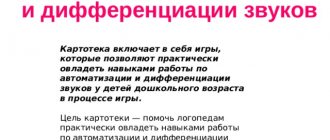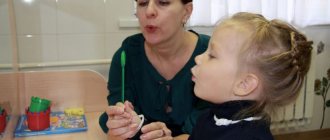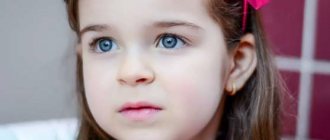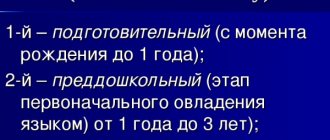Modern studies of dysarthria in domestic and foreign speech therapy
Dysarthria, as a complex speech defect, is being intensively studied and covered by domestic and foreign scientists, various methods, diagnostic and correction techniques are being developed, this topic remains relevant in domestic and foreign speech therapy. Dysarthria as a specific disorder of the sound-pronunciation aspect of speech is caused by insufficiency of innervation of the articulatory, vocal and respiratory apparatus [1].
The scientific approach to the study of the problem of dysarthria was first applied by the German neurologist Little. While studying this disorder in children, he described speech disorders characteristic of dysarthria. The term “dysarthria” itself was first introduced by A. Kussmaul, by which he understood all violations of the phonetic side of speech in children and adults. And only in the middle of the twentieth century, dysarthria will be considered as a complex speech defect, in which not only the phonetic, but also the prosodic side of speech is impaired [2].
Speech disorders of a dysarthric nature can occur with various organic brain lesions that are formed under the influence of unfavorable factors during sensitive periods of child brain development. Unfavorable factors in the development of the nervous system include the pathology of pregnancy: chronic endogenous diseases of a pregnant woman, exposure to radiation, the harmful effects of alcoholism, fetal trauma and a number of other pathogenic factors. In the natal period, dysarthria can be caused by such pathophysiological phenomena as rapid or protracted labor, weakness of labor in pregnant women, asphyxia of newborns, etc. Also in the pathogenesis of the etiology of dysarthria, a large share is occupied by neuroinfectious diseases in children, traumatic brain injuries, severe somatic diseases that occur with complications in the central nervous system [3].
In Russian speech therapy science, speech-language forms of dysarthria have been identified and described, taking into account the leading neurological syndrome.
Focal damage to the motor cranial nuclei of the brainstem causes the bulbar form of dysarthria. The main pathological manifestations of a neurological nature are muscle weakness, decreased tone, weakening of voluntary and involuntary articulatory movements. External speech is pronounced blurry, sounds that are close in acoustic similarity are mixed.
With bilateral focal lesions of the pyramidal tract, a pseudobulbar form of dysarthria occurs. Symptoms of which occur in the form of bilateral paralysis of the muscles of the speech apparatus.
Damage to the cerebellum causes the cerebellar form of dysarthria. Cerebellar dysarthria is characterized by atony of the muscles of the entire speech apparatus and decreased tone of the articulation muscles. As a result, scanned pronunciation of speech occurs, slowness and jerkiness of the formation of speech elements [4].
Subcortical dysarthria occurs as a consequence of damage to the subcortical nuclei of the brain. This form is characterized by a violation of spatial coordination of the articulatory organs, changes in muscle tone in the speech organs, and changes in movements such as hypokinesia and hyperkinesia in the articulatory muscles.
The most difficult in terms of manifestations and differentiation possibilities is cortical dysarthria. It is formed when the secondary motor zones of the left hemisphere of the cerebral cortex are damaged. There are efferent and afferent forms. With the efferent form of dysarthria, all movements responsible for sound pronunciation are difficult, most often they break up into separate motor elements. With afferent dysarthria, spastic disturbances in muscle movement and paresis of speech muscles appear.
In the pediatric clinic of dysarthria, the presented forms are distinguished conditionally, since their neurological symptoms occur against the background of residual cerebral phenomena [2].
The degree of manifestation of dysarthric disorders of neurological and speech syndrome depends on the nature and severity of damage to the child’s central nervous system. In the studies of E.F. Arkhipova revealed that the severe form is most often found in children with cerebral palsy. Anarthria is characterized by a complete absence of phonetic pronunciation abilities. It is observed against the background of paralysis of the muscles of the speech apparatus. According to the severity of its manifestations, anarthria can vary (I. I. Panchenko): complete absence of spoken speech and voice; only vocal reactions such as humming; the presence of sound-syllable activity, such as babbling manifestations [6].
Average degree of dysarthria is more common in children with intellectual development delays of various etiologies. With this severity of the disorder, there are disturbances in the clarity and accuracy of speech pronunciation, it is slurred and difficult to understand, and there are distortions of several groups of phonemes. There are changes in phonation, the voice is unmodulated, causing speech to become monotonous.
Children with general speech underdevelopment (50-80%) and phonetic underdevelopment (30-40%) exhibit a mild degree of dysarthria [5]. E.F. Arkhipova introduced a term to designate such a disorder of sound pronunciation as “erased” dysarthria. The main manifestations of the latter are minor paresis of the articulatory muscles. The speech of a child with such a pathology is quite understandable for others, but existing sound pronunciation disorders manifest themselves in distortions and substitutions of some sounds for lighter ones. Most often these are phonemes formed in late ontogenesis.
In general, when characterizing speech disorders in dysarthria, domestic speech therapists note general signs characteristic of this polymorphic syndrome: disturbances in sound pronunciation, insufficiency of articulatory motor skills, changes in speech breathing, phonation and prosodic aspects of speech [7].
O.G. Prikhodko clarifies the characteristics of dysarthric disorders and notes the persistent nature of sound pronunciation disorders in children, as well as specific difficulties in automating sounds when correcting them [8].
The works of all specialists in the field of dysarthria note the leading signs of a neurological nature that explain the specifics of speech disorders and characterize the differential symptoms of dysarthria. Marked weakening of muscle contractions, pareticity of the speech apparatus, difficulty maintaining a closed mouth posture, lack of pronounced tension in the muscles of the lips and tongue. When performing articulatory movements, muscle flaccidity increases, movements quickly fade away, and become exhausted.
There may be a state of increased tone in some muscles. The phenomenon of spasticity manifests itself in the difficulties of the child’s facial reactions, tension of the lips and tongue. There are involuntary movements of the speech muscles, hyperkinesis manifests itself in the form of trembling of the tongue, lips, facial muscles, and vocal folds. In almost any form and degree of manifestation of dysarthria, hypersalivation phenomena are observed. Increased salivation occurs, especially when performing speech movements [5].
A pronounced sign of dysarthria is a violation of phonation characteristics. Voice reactions in dysarthria are characterized by insufficient strength, nasalization of the voice and changes in modulation are observed [9,10].
Speech breathing disorders are associated with insufficient volume of exhaled air, as well as impaired coordination of speech exhalation. The speech flow of air is weak; frequent, untimely intake of air is produced when pronouncing words and phrases [11].
The above symptoms of a neurological nature of speech disorder in dysarthria cause persistent disturbances in the melodic-intonation and tempo-rhythmic design of coherent speech. With this form of speech dysontogenesis, changes in voice timbre and difficulties in voluntary reproduction of differentiated intonation elements are observed. Children with dysarthria experience difficulties in identifying and placing logical stress in words and phrases, and organizing correct pausing of statements. They have poor speech intonation, rhythmic inconsistency of speech during communication, and motor incoordination of the speech apparatus [12].
Thus, dysarthria is a type of speech dysontogenesis, which manifests itself in a violation of motor speech implementation. The concept of dysarthria is considered in clinical, speech therapy, psychological and linguistic aspects. Today, in speech therapy, the structure of speech defects has been described, classifications and priority directions for studying this issue have been developed.
L.S. Volkova – Speech therapy
This textbook on speech therapy (3rd edition) is intended for students of defectology faculties (Faculties of Correctional Pedagogy) of pedagogical universities and institutes. The textbook is aimed at improving the quality of training of teachers-defectologists, at increasing the effectiveness of speech therapy work with children, adolescents, and adults. It conveys the idea that the formation of correct speech and other functional systems in children with speech disorders and the correction of their behavior represent a single, organized, purposeful educational and educational process. The textbook reflects the current state and trends in the further development of speech therapy as a science and practice of correctional influence.
The material in the textbook is presented in accordance with the curriculum of speech therapy departments of defectology faculties, with the speech therapy course program, with the state standard for training personnel in this specialty. In recent years, the methodological principles of speech therapy have been deepened, its software and methodological support has been created, and a number of fundamental and practice-oriented studies have been carried out aimed at studying, overcoming and preventing speech development disorders. The main ones of these materials are reflected in the textbook. When preparing the textbook, the authors took into account that the mastery of speech therapy is preceded by the students’ knowledge gained from studying related disciplines: psychology, pedagogy, psycholinguistics, medicine.
The textbook uses and combines the achievements of a number of disciplines that study speech and speech activity, from the physiology of higher nervous activity to general linguistics. The authors sought to ensure that integrated psychological, pedagogical and psycholinguistic approaches would prevail in assessing speech defects and overcoming them.
The textbook consists of four sections and corresponding chapters. The first section of the textbook discusses the theoretical and methodological foundations of speech therapy. The subsequent ones outline the doctrine of various speech disorders and ways to overcome them, issues of organizing speech therapy work, and the history of speech therapy in accordance with each problem under consideration. A terminological glossary is provided at the end of the textbook.
Each chapter, which reveals speech disorders and ways to overcome them, provides for: characteristics of speech disorders in a historical aspect, etiology, mechanisms, symptoms, classification, dynamics, methods and techniques of speech therapy examination and intervention, issues of organizing speech therapy care and prevention of speech disorders. All chapters end with main conclusions, test questions and assignments, as well as a list of references.
The textbook provides the most established definitions of speech disorders, clarified and supplemented by the team of authors.
The content of the textbook, its structure, identification of current problems, test questions and assignments, literature for each chapter provide for the creation of maximum opportunities for enhancing the independent and research work of students in speech therapy.
When preparing the textbook, the traditional approach to resolving issues of speech disorders, laid down by the founders of domestic speech therapy and presented in textbooks and manuals (N. A. Vlasova, R. E. Levina, V. K. Orfinskaya, O. V. Pravdina, E. F. Pay and F. A. Pay, M. E. Khvattseva, etc.), as well as new scientific data. Data from speech therapy science and practice were taken into account, reflecting the current state and trends in the further development of domestic and foreign theory and practice of speech therapy.
The main focus is on training a speech therapist to work with children of preschool and school age. This emphasizes the focus of speech therapy on preventing the further development of speech defects and their impact on the formation of the child’s personality. In this regard, only certain sections of the textbook discuss issues of correction of speech disorders in adults.
This textbook was prepared by a team of authors, which included speech therapists and doctors from the defectology faculties of Moscow State Pedagogical University, Russian State Pedagogical University, Moscow State Pedagogical Institute and the Institute of Correctional Pedagogy of the Russian Academy of Education.
The authors of the chapters are: chapter 1 - L. S. Volkova, R. I. Lalaeva, E. M. Mastyukova; chapters 2, 3, 8, 18 - E. M. Mastyukova; chapters 4.6 - B. M. Grinshpun, chapter 5 - L. S. Volkova, R. I. Lalaeva; chapter 7 - G. V. Chirkina, chapter 9 - E. V. Lavrova; chapters 10, 11 - G. A. Volkova, V. I. Seliverstov; chapter 12 - B. M. Grinshpun, S. N. Shakhovskaya; Chapter 13 - M.K. Burlakova; chapters 14, 17, 19 - R. I. Lalaeva; chapter 15 - L. G. Paramonova; Chapter 16 - L. S. Volkova; chapters 20, 21, 22, 23 - T. B. Filicheva, G. V. Chirkina; Chapter 24 —- L. I. Belyakova
The team of authors expresses sincere gratitude to everyone who took the trouble to deeply and critically review the textbook, as well as take part in its discussion.
Section I Theoretical foundations of speech therapy
CHAPTER 1. SUBJECT, PURPOSE AND OBJECTIVES OF Speech Therapy. RELATIONSHIP OF Speech Therapy with OTHER SCIENCES. THEORETICAL FOUNDATIONS OF Speech Therapy. PRINCIPLES AND METHODS OF Speech Therapy. THE IMPORTANCE OF Speech Therapy. PERSONALITY OF Speech Therapist, CURRENT PROBLEMS OF MODERN Speech Therapy. CONCEPTUAL-CATEGORIAL APPARATUS OF Speech Therapy
SUBJECT AND TASKS OF Speech Therapy
Speech therapy
is the science of speech disorders, methods of their prevention, identification and elimination by means of special training and education. Speech therapy studies the causes, mechanisms, symptoms, course, structure of speech disorders, and the system of correctional interventions.
The term “speech therapy” comes from the Greek roots: logos
(word),
paideo
(educate, teach) - and translated means “education of correct speech.”
The subject of speech therapy
as a science are
speech disorders and the process of training and education
of persons with speech disorders.
The object of study is a person
(individual) suffering from a speech disorder.
Speech disorders are studied by physiologists, neuropathologists, psychologists, linguists, etc. Moreover, everyone views them from a certain angle in accordance with the goals, objectives and means of their science. Speech therapy considers speech disorders from the standpoint of prevention and overcoming by means of specially organized training and education, therefore it is classified as special pedagogy.
Structure
Modern
speech therapy
consists of
preschool, school
speech therapy and speech therapy
for adolescents and adults.
The main goal of speech therapy
is the development of a scientifically based system of training, education and re-education of persons with speech disorders, as well as the prevention of speech disorders.
Domestic speech therapy creates the most favorable conditions for the personality development of children with speech disorders. The successes of domestic speech therapy are based on numerous modern studies by domestic and foreign authors, indicating the great compensatory capabilities of the developing children's brain and the improvement of ways and methods of speech therapy correction. I. P. Pavlov, emphasizing the extreme plasticity of the central nervous system and its unlimited compensatory capabilities, wrote: “Nothing remains motionless, inflexible, but can always be achieved, changed for the better, if only the appropriate conditions are met.”
Based on the definition of speech therapy as a science, the following tasks can be distinguished:
1. Study of the ontogenesis of speech activity in various forms of speech disorders.
2. Determination of the prevalence, symptoms and severity of speech disorders.
3. Identification of the dynamics of spontaneous and directed development of children with speech disorders, as well as the nature of the influence of speech disorders on the formation of their personality, on mental development, on the implementation of various types of behavioral activities.
4. Study of the features of speech formation and speech disorders in children with various developmental disabilities (with impairments of intelligence, hearing, vision and the musculoskeletal system).
5. Clarification of the etiology, mechanisms, structure and symptoms of speech disorders.
6. Development of methods for pedagogical diagnosis of speech disorders.
7. Systematization of speech disorders.
8. Development of principles, differentiated methods and means of eliminating speech disorders.
9. Improving methods for preventing speech disorders.
10. Development of issues related to the organization of speech therapy assistance.
In the indicated tasks of speech therapy, both its theoretical and practical orientation are determined. Theoretical
its
aspect
is the study of speech disorders and the development of scientifically based methods for their prevention, identification and overcoming.
The practical aspect
is the prevention, identification and elimination of speech disorders. The theoretical and practical tasks of speech therapy are closely related. To solve the tasks it is necessary:
• use of interdisciplinary connections and involvement in cooperation of many specialists who study speech and its disorders (psychologists, neuropsychologists, neurophysiologists, linguists, teachers, doctors of various specialties, etc.);
• ensuring the relationship between theory and practice, connection between scientific and practical institutions for faster implementation of the latest scientific achievements into practice;
• implementation of the principle of early detection and overcoming speech disorders;
• dissemination of speech therapy knowledge among the population for the prevention of speech disorders.
The solution to these problems determines the course of speech therapy intervention.
The main focus of speech therapy is speech development, correction and prevention of speech disorders. In the process of speech therapy work, the development of sensory functions is provided; development of motor skills, especially speech motor skills; development of cognitive activity, primarily thinking, memory processes, attention; formation of the child’s personality with simultaneous regulation and correction of social relationships; impact on the social environment.
The organization of the speech therapy process makes it possible to eliminate or mitigate both speech and psychological disorders, contributing to the achievement of the main goal of pedagogical influence - the education of a person.
Speech therapy intervention should be aimed at both external and internal factors causing speech disorders. It is a complex pedagogical process aimed primarily at the correction and compensation of speech impairments.







